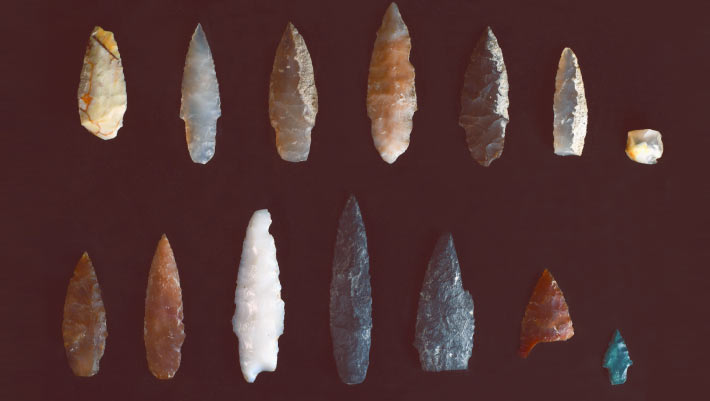Archaeologists have unearthed an assemblage of 14 stemmed projectile points at the Cooper’s Ferry site, located on a terrace of the lower Salmon River of western Idaho, the United States. These stemmed points are several thousand years older than Clovis fluted points and are 2,300 years older than stemmed points found previously at the Cooper’s Ferry site.
The 15,700-year-old stone projectile points from the Area B of the Cooper’s Ferry site in Idaho, the United States. Image credit: Loren Davis.
“From a scientific point of view, these discoveries add very important details about what the archaeological record of the earliest peoples of the Americas looks like,” said Oregon State University’s Professor Loren Davis, lead author on the study.
“It’s one thing to say, ‘We think that people were here in the Americas 16,000 years ago;’ it’s another thing to measure it by finding well-made artifacts they left behind.”
Previously, Professor Davis and colleagues working the Cooper’s Ferry site had found simple flakes and pieces of bone that indicated human presence about 16,000 years ago.
“But the discovery of projectile points reveals new insights into the way the first Americans expressed complex thoughts through technology at that time,” Professor Davis said.
“The points are revelatory not just in their age, but in their similarity to projectile points found in Hokkaido, Japan, dating to 16,000-20,000 years ago.”
“Their presence in Idaho adds more detail to the hypothesis that there are early genetic and cultural connections between the ice age peoples of Northeast Asia and North America.”
“The earliest peoples of North America possessed cultural knowledge that they used to survive and thrive over time.”
“Some of this knowledge can be seen in the way people made stone tools, such as the projectile points found at the Cooper’s Ferry site.”
“By comparing these points with other sites of the same age and older, we can infer the spatial extents of social networks where this technological knowledge was shared between peoples.”
These slender projectile points are characterized by two distinct ends, one sharpened and one stemmed, as well as a symmetrical beveled shape if looked at head-on.
They were likely attached to darts, rather than arrows or spears, and despite the small size, they were deadly weapons.
“There’s an assumption that early projectile points had to be big to kill large game; however, smaller projectile points mounted on darts will penetrate deeply and cause tremendous internal damage,” Professor Davis said.
“You can hunt any animal we know about with weapons like these.”
“These discoveries add to the emerging picture of early human life in the Pacific Northwest.”
“Finding a site where people made pits and stored complete and broken projectile points nearly 16,000 years ago gives us valuable details about the lives of our region’s earliest inhabitants.”
The team’s paper was published in the journal Science Advances.
_____
Loren G. Davis et al. 2022. Dating of a large tool assemblage at the Cooper’s Ferry site (Idaho, USA) to ~15,785 cal yr B.P. extends the age of stemmed points in the Americas. Science Advances 8 (51); doi: 10.1126/sciadv.ade1248




